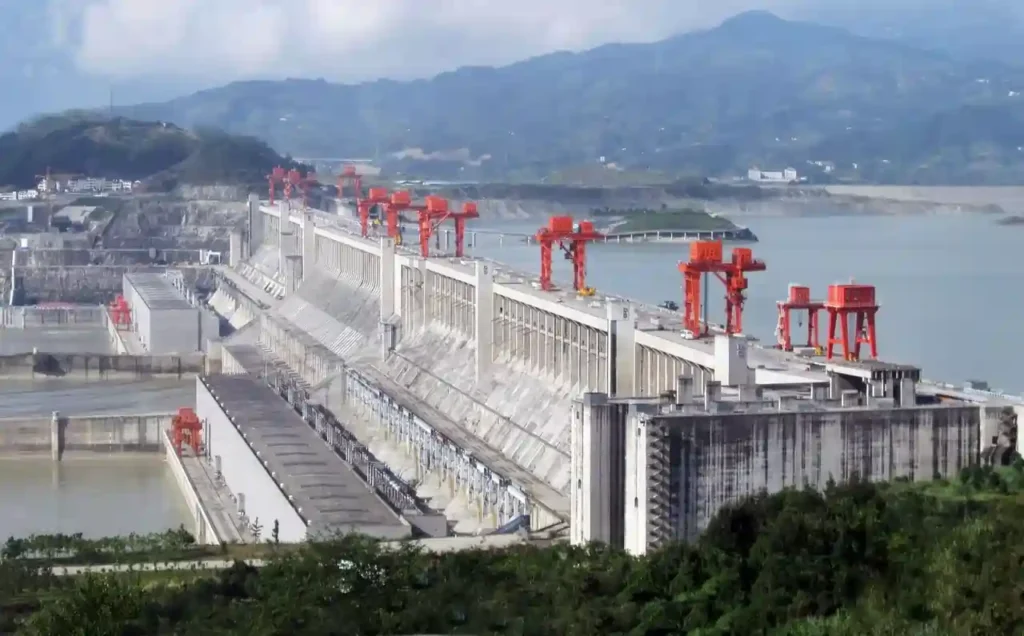New Delhi: On Saturday, July 19, 2025, Chinese Premier Li Qiang announced the commencement of construction for what is set to become the world’s largest hydropower dam on the Yarlung Tsangpo River, located at the eastern rim of the Tibetan Plateau in Nyingchi City. This ambitious $170 billion project, hailed as the largest infrastructure development globally, is poised to surpass China’s iconic Three Gorges Dam on the Yangtze River in both scale and capacity. The Yarlung Tsangpo dam, expected to be operational in the 2030s, has sparked significant concerns from downstream nations India and Bangladesh, as well as environmental and non-governmental organizations (NGOs), due to its potential ecological, geopolitical, and cultural impacts.

Project Overview: A Monumental Undertaking
The Yarlung Tsangpo River, stretching 2,900 kilometers, originates in the Himalayas and carves through the world’s deepest land-based canyon, dropping 2,000 meters in elevation over a 50-kilometer stretch. This dramatic topography offers immense hydropower potential, which China aims to harness through a complex of five cascade hydropower stations. The project, overseen by the newly formed state-owned China Yajiang Group, is estimated to cost 1.2 trillion yuan (approximately $167.8 billion) and will generate 300 billion kilowatt-hours of electricity annually—an output equivalent to the United Kingdom’s total electricity consumption in 2024.
China’s stated objectives for the dam include expanding renewable energy, reducing carbon emissions, and boosting economic development in the Tibet region. The electricity generated will primarily be transmitted to other regions of China, while also meeting local power demands in Tibet. The Chinese government has described the project as a “project of the century,” emphasizing ecological conservation to mitigate environmental damage. However, the lack of transparency regarding the number of people displaced by the project has raised eyebrows globally.
Strategic and Economic Implications
The commencement of construction has already had a ripple effect on Chinese markets, with the CSI Construction & Engineering Index jumping 4% to a seven-month high on Monday, July 21, 2025. Companies such as Power Construction Corporation of China and Arcplus Group PLC saw their shares surge by their 10% daily limit, while firms like Hunan Wuxin Tunnel Intelligent Equipment Co and Geokang Technologies Co Ltd, which supply tunnel construction equipment and intelligent monitoring terminals, respectively, experienced a 30% increase in share prices. Cement and explosive material producers, including Xizang Tianlu Co Ltd and Tibet GaoZheng Explosive Co, also saw significant gains.
Analysts at Huatai Securities noted that the project will drive demand for construction materials such as cement and civil explosives. Citi estimates that, assuming a 10-year construction period, the project could contribute 120 billion yuan ($16.7 billion) annually to China’s GDP, with potential economic benefits extending beyond this figure. The Three Gorges Dam, which took nearly two decades to complete and generated nearly a million jobs, serves as a precedent, though it also displaced a similar number of people—a detail yet to be clarified for the Yarlung Tsangpo project.
Geopolitical Tensions: A “Water Bomb” Threat
The Yarlung Tsangpo River, known as the Brahmaputra River as it flows south into India and Bangladesh, is a lifeline for millions who depend on it for water and agriculture. The dam’s location, near the India-China border in Arunachal Pradesh, has heightened geopolitical tensions. India’s Foreign Ministry has urged China to ensure that upstream activities do not harm downstream states, emphasizing the need to protect the interests of millions living along the Brahmaputra. In January 2025, India announced it would monitor the project and take necessary measures to safeguard its interests.
Arunachal Pradesh Chief Minister Pema Khandu has labeled the dam a “ticking water bomb,” warning that it could dry out 80% of the river’s flow through the Indian state or cause devastating floods if used as a geopolitical weapon. A 2020 report by the Lowry Institute, an Australian think tank, underscored China’s potential to exert control over India’s economy through its dominance over transboundary rivers. Bangladesh, another downstream nation, shares these concerns, as the Brahmaputra is critical to its agricultural and water security.
China’s Foreign Ministry, in December 2024, claimed the project would have no “negative impact” downstream and pledged to maintain communication with lower riparian countries. However, neither China nor India are signatories to the United Nations Convention on the Law of the Non-Navigational Uses of International Watercourses (1997), complicating efforts to enforce cooperative management of shared rivers. The Expert Level Mechanism (ELM), established in 2006 between India and China, facilitates the sharing of hydrological data on the Brahmaputra and Sutlej rivers during flood seasons. This mechanism was a key topic during talks between India’s National Security Advisor Ajit Doval and Chinese Foreign Minister Wang Yi on December 18, 2024.
Environmental and Seismic Risks
The dam’s location on the Tibetan Plateau, one of the most ecologically sensitive and seismically active regions in the world, raises significant concerns. The plateau, situated over tectonic plate boundaries, is prone to frequent earthquakes, such as the devastating 1950 Assam-Tibet Earthquake. Experts warn that the dam’s construction in this volatile zone could increase the risk of catastrophic disasters.
Environmentalists and NGOs have highlighted the potential for irreversible damage to the plateau’s unique ecosystem, which is home to some of the world’s richest biodiversity. The dam could disrupt local ecology and downstream water flow, threatening agriculture and livelihoods in India and Bangladesh. The project’s impact on the Brahmaputra’s flow could also alter the delicate balance of the world’s deepest canyon, carved by the river over millennia.
Cultural and Social Impacts
The dam threatens the cultural heritage and livelihoods of indigenous communities, such as the Adi Tribe in the Siang Valley of Arunachal Pradesh. These tribes rely on the Brahmaputra for their sustenance and cultural practices, and the dam’s construction could displace communities and disrupt their way of life. Chinese authorities have not disclosed how many people will be displaced, adding to concerns about the project’s social impact.
In response to China’s project, India is developing its own hydropower dam on the Brahmaputra in Arunachal Pradesh, signaling a regional race to harness the river’s potential. This development further complicates the geopolitical dynamics surrounding the river.
China’s Assurances and Global Reactions
Chinese Premier Li Qiang emphasized the need for ecological conservation during the groundbreaking ceremony, as reported by Xinhua on July 19, 2025. Beijing has assured downstream nations that the dam will not disrupt water supplies or harm the environment. However, skepticism persists, given the lack of concrete details about mitigation measures and displacement plans.
The international community, including NGOs, has called for greater transparency and cooperation to address the dam’s potential impacts. The project’s scale and its location in a geopolitically sensitive and ecologically fragile region have made it a focal point for global discussions on transboundary river management and sustainable development.
Economic Stimulus and Market Reactions
The dam’s construction is seen as a major boost to China’s economy, which has shown signs of faltering. Government bond yields rose on July 21, 2025, with 30-year treasury futures falling to five-week lows, as investors interpreted the project as part of China’s broader economic stimulus strategy. The project’s long-term economic benefits, coupled with its potential to create jobs and drive demand for construction materials, have fueled optimism in Chinese capital markets.
Looking Ahead: Challenges and Opportunities
As the Yarlung Tsangpo dam moves forward, it represents both an engineering marvel and a complex challenge. Its potential to generate clean energy and stimulate economic growth is undeniable, but the risks—seismic, environmental, cultural, and geopolitical—cannot be ignored. The project’s success will depend on China’s ability to balance its ambitions with the concerns of downstream nations and the global community.
India and Bangladesh, alongside international organizations, will closely monitor the project’s progress. The 2030s, when the dam is expected to become operational, will mark a critical juncture in the management of one of Asia’s most vital rivers. For now, the Yarlung Tsangpo dam stands as a symbol of China’s infrastructure prowess and a test of its commitment to regional cooperation and environmental stewardship.
Conclusion
The Yarlung Tsangpo hydropower dam, with its unprecedented scale and $170 billion price tag, is set to redefine global infrastructure benchmarks. However, its proximity to the India-China border, seismic risks, and potential to disrupt the lives of millions downstream have made it a lightning rod for controversy. As China embarks on this “project of the century,” the world watches closely, weighing the promise of renewable energy against the perils of ecological and geopolitical fallout.
Frequently Asked Questions
1. What is the Yarlung Tsangpo Dam, and why is it significant?
The Yarlung Tsangpo Dam is a $170 billion hydropower project on the Yarlung Tsangpo River in Tibet, announced by Chinese Premier Li Qiang on July 19, 2025. It is set to become the world’s largest hydropower dam, surpassing the Three Gorges Dam, with a capacity of 60,000 MW and an annual output of 300 billion kilowatt-hours. Its significance lies in its potential to generate renewable energy, boost China’s economy, and meet Tibet’s power needs, but it also raises environmental, geopolitical, and cultural concerns due to its location near the India-China border.
2. Why are India and Bangladesh concerned about the dam?
The Yarlung Tsangpo River becomes the Brahmaputra River as it flows into India and Bangladesh, where millions rely on it for water and agriculture. The dam’s construction could disrupt downstream water flow, threatening livelihoods and ecosystems. India’s Arunachal Pradesh Chief Minister Pema Khandu called it a “ticking water bomb” due to risks of flooding or reduced water flow. Geopolitically, the dam’s proximity to the India-China border raises fears that China could use it to control water as a strategic tool, impacting India’s economy and Bangladesh’s water security.
3. What are the environmental and seismic risks associated with the dam?
The dam is located on the seismically active Tibetan Plateau, prone to earthquakes like the 1950 Assam-Tibet Earthquake, increasing the risk of catastrophic disasters. Environmentally, it threatens the plateau’s rich biodiversity and could disrupt the world’s deepest canyon, carved by the river. NGOs warn of irreversible ecological damage and impacts on downstream agriculture due to altered water flow, particularly in one of the rainiest regions of the Himalayas.
4. How has China responded to concerns from downstream countries?
In December 2024, China’s Foreign Ministry stated that the dam would have no “negative impact” on downstream water supplies or the environment and committed to ongoing communication with India and Bangladesh. The 2006 Expert Level Mechanism (ELM) facilitates hydrological data sharing on the Brahmaputra during flood seasons. However, China has not disclosed details about displacement or specific mitigation measures, leading to skepticism about its assurances.
5. What are the economic and cultural impacts of the dam?
Economically, the dam is expected to stimulate China’s economy, creating jobs and driving demand for construction materials, with a potential annual GDP boost of 120 billion yuan ($16.7 billion). Chinese markets saw a surge in related stocks on July 21, 2025. Culturally, the project threatens indigenous communities like the Adi Tribe in India’s Siang Valley, whose livelihoods and heritage depend on the Brahmaputra. The lack of clarity on displacement adds to concerns about social impacts.

